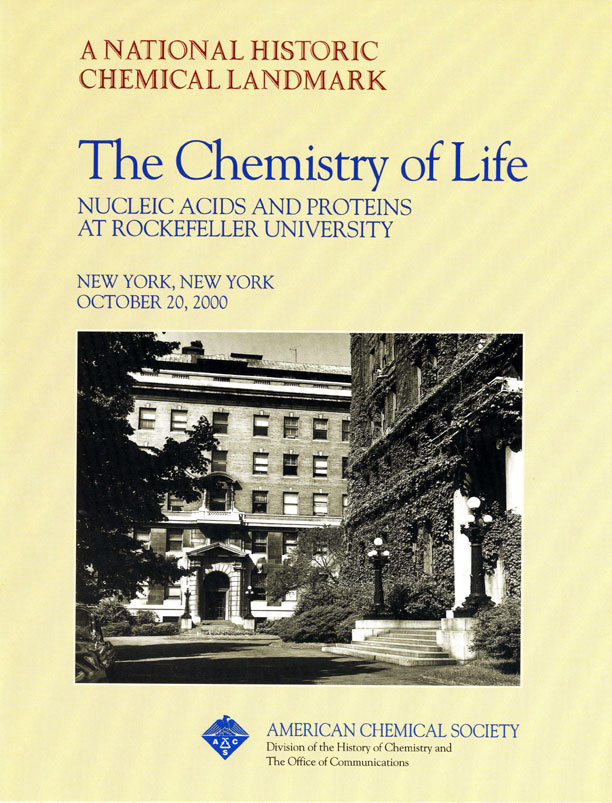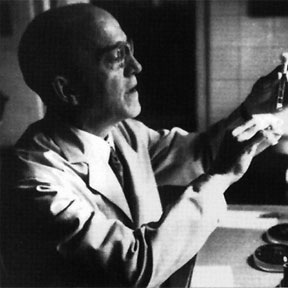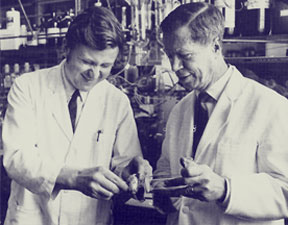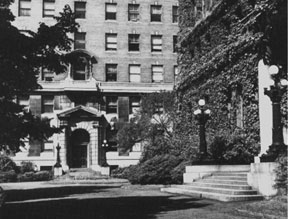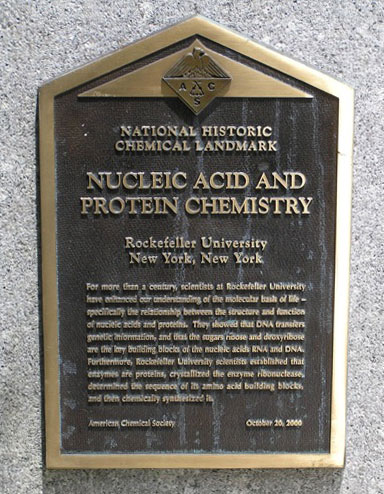Nucleic Acid and Protein Research at Rockefeller University
Dedicated October 20, 2000, at Rockefeller University in New York City, New York.
John D. Rockefeller, the legendary oil magnate and philanthropist, founded the university that bears his name in 1901 after his grandson died from scarlet fever. Originally called the Rockefeller Institute for Medical Research, it was the first institution in the United States devoted solely to biomedical research—to understanding the underlying causes of disease. Scientists at Rockefeller discovered that genes are made of DNA, found the Rh factor in blood, demonstrated the connection between cholesterol and heart disease, developed vaccines against meningitis, and introduced methadone to manage heroin addiction. Of the 21 Nobel laureates associated with Rockefeller, five received the prize in chemistry.
Contents
- Chemical Research at Rockefeller University
- Chemistry of Life: Proteins and Nucleic Acids
- William H. Stein and Stanford Moore: Structure and Activity of the Ribonuclease Molecule
- Bruce Merrifield: Synthesis of Peptides and Proteins
- Rockefeller University Today
- Further Reading
- Landmark Dedication and Acknowledgments
- Cite this Page
Chemical Research at Rockefeller University
Much of the work by chemists at Rockefeller was, and continues to be, conducted in Flexner Hall. The building is named for Simon Flexner, Rockefeller's first director. Flexner recruited Phoebus A. Levene, a Russian who had studied with the great German chemist, Emil Fischer, to establish a chemical laboratory in 1905.
Levene's research during his 45-year career at Rockefeller centered on isolating and identifying organic compounds, including carbohydrates, proteins, lipids, and nucleic acids, from living systems. He and his team studied RNA and DNA, and identified ribose and deoxyribose as their key building blocks. They also isolated and named adenosine, one of the basic units of DNA and RNA. This work provided a firm foundation for much of what was to follow.
Physical chemistry arrived at Rockefeller in 1926 with Duncan MacInnes. Previously affiliated with the Massachusetts Institute of Technology, he was interested in the properties of ions in solution. For this work, MacInnes, a superb instrumentalist, developed a vastly improved version of the glass electrode. Leonor Michaelis, who was already well known for his work in enzyme kinetics, started a second physical chemistry laboratory at Rockefeller in 1929. At Rockefeller, Michaelis' studies were centered on biological oxidation-reduction reactions.
Chemistry of Life: Proteins and Nucleic Acids
Much of the research at Rockefeller has revolved around the nucleic acids RNA (ribonucleic acid) and DNA (deoxyribonucleic acid) and proteins.
Chemistry of Nucleic Acids (DNA and RNA)
When Oswald T. Avery, a graduate of Columbia University's medical school, joined Rockefeller in 1913, his goal was to understand the pneumococcus bacteria and design therapies for lobar pneumonia, then a life-threatening disease. Ultimately, he demonstrated that DNA is the material that transfers genetic information.
Fred Griffith, a British medical researcher, had injected a nonvirulent strain of pneumococci (R-pneumococci) in mice along with dead cells of a virulent form of pneumococci (S-pneumococci). The mice died and live S-pneumococci were found in their lungs. Avery set out to answer the question: How did this occur?
Researchers in Avery's laboratory eventually duplicated Griffith's results in a test tube, using bacteria instead of mice. They found that replacing the dead S-bacteria with a crude cell-free extract of the same bacteria transformed the nonvirulent bacteria into the virulent strain. The finding had far-reaching implications.
In 1944, Avery and two senior associates, Colin MacLeod and Maclyn McCarty, published their conclusion: DNA, and DNA alone, was the material with genetic properties. This finding was a direct challenge to the then-current dogma that only proteins — more complex and more intricately folded molecules — existed in the multitude of forms needed to store the genetic blueprint for an entire organism.
DNA contains the genes that control the structure and functioning of the body. It is made of alternating deoxyribose and phosphoric acid molecules, which combine to form a chain. Four "bases" — adenine, thymine, guanine, and cytosine, or A, T, G and C — are attached to this chain, each linking to a deoxyribose unit. The sequence of bases along the DNA molecule forms a coded message that tells the cell how to manufacture protein. Your DNA, unless you are an identical twin, is distinct from everyone else's. The difference is in the order of the bases.
Chemistry of Proteins and Enzymes
John H. Northrop probably did more than any other individual to establish the view that pure enzymes are indeed proteins. He became associated with Rockefeller in 1916, after earning his Ph.D. in chemistry at Columbia University and serving as a captain in the Chemical Warfare Service during World War I, where he devised a process for producing acetone from potatoes.
Northrop studied the kinetics of enzyme-catalyzed reactions and the conditions affecting the action of the digestive enzymes pepsin and trypsin. In 1931, he developed solubility methods to determine the homogeneity of protein preparations. These methods helped prove that enzymes are proteins.
Between 1930 and 1935, Northrop crystallized pepsin. His colleague, Moses Kunitz, crystallized trypsin, chymotrypsin, ribonuclease, deoxyribonuclease, hexokinase, and pyrophosphatase and used the most rigorous test then available to demonstrate they, too, are pure proteins.
In later studies, Northrop discovered that bacteria-invading agents known as bacteriophages — long thought of as living organisms — could be isolated as chemical substances. The finding helped prove that bacteriophages are viruses and paved the way for scientists to study viruses in bacteria.
Northrop's findings led him to theorize, correctly, that viruses can transfer genetic information from one cell to another. In 1946, he and Wendell M. Stanley shared half the Nobel Prize "for their preparation of enzyme and virus proteins in a pure form." (James Sumner received the other half of the prize.) The award also recognized the philosophical importance of the link between living and nonliving matter discovered by Stanley.
William H. Stein and Stanford Moore: Structure and Activity of the Ribonuclease Molecule
When Wendell Stanley joined Rockefeller in 1931, the term "virus" was used to describe submicroscopic pathogenic agents able to multiply only within living cells. What a virus actually was — a small organism, a living fluid, or a chemical molecule — was still a mystery.
In 1935, Stanley isolated needle-like crystals of the tobacco mosaic virus (TMV) that were 1,000 times more infectious than the juice from which they were made. He determined that the virus's protein had all the usual attributes of a pure chemical compound. In fact, it appeared to be a giant chemical molecule. Leading molecular biologists of the next generation characterized Stanley's finding as the effective beginning of molecular biology.
Subsequently, Frederick Bawden and Norman Pirie, then working at Cambridge, in England, found that TMV is about 94 percent protein and 6 percent nucleic acid (RNA). They determined that the active substance is not, as Stanley had supposed, a simple protein of high molecular weight, but a nucleoprotein — a protein chemically combined with a nucleic acid. Moreover, the nucleic acid portion of the virus enables it to reproduce when introduced into a living cell.
William H. Stein (1911-1980) and Stanford Moore (1913-1982), who came to Rockefeller as postdoctoral fellows in the late 1930s, joined forces to fill the gaps in knowledge about protein structure. Scientists had determined that proteins function as enzymes, antibodies, hormones, oxygen carriers, and as the major building blocks of body tissue. But little was known of their structure — not even the composition of the amino acids that comprised a single protein.
In collaboration with Darrel Spackman, a young member of the laboratory, Stein and Moore invented an amino acid analyzer that automated and vastly accelerated the process of separating and quantifying the amino acids in a protein. Today, laboratories all over the world use the commercial descendants of this analyzer to determine the composition of purified proteins, physiological fluids, and foods.
Beginning in 1949, Stein, Moore, and a colleague, C. H. W. Hirs, began using these analytical methods to isolate and study the primary structure of bovine pancreatic ribonuclease, an enzyme that catalyzes the breakdown of RNA. (This enzyme had been isolated by Renè Dubos at Rockefeller.) In 1963, Stein, Moore and Hirs published the entire amino acid sequence for ribonuclease A — the first description of an enzyme's chemical structure and the largest protein decoded at that time.
Stein and Moore received the Nobel Prize in chemistry in 1972, along with Christian B. Anfinsin of the National Institutes of Health. The award recognized their contributions to understanding the interrelationships between the structure and activity of the ribonuclease molecule.
Proteins in the Body
Proteins, the bulk of the solid matter of cells, get their name from the Greek "proteios" for primary. They are the principal material of skin, muscle, tendons, nerves, blood, enzymes, antibodies, and many hormones. Some proteins, such as the hemoglobin that carries oxygen in red blood cells, are involved in transport and storage. Others, like insulin, are hormones, the chemical messengers that coordinate body activities. Immunoglobulins, also proteins, are the master molecules of immunity. The enzymes that are the catalysts for body processes—they can increase the speed of a chemical reaction more than a millionfold—are also proteins.
Bruce Merrifield: Synthesis of Peptides and Proteins
In 1959, Bruce Merrifield (1921-2006) described in his laboratory notebook the idea that would revolutionize peptide synthesis: He would attach an amino acid to an insoluble solid support and add others to it sequentially to create an insoluble peptide. The growing chains could be freed of excess reagents by a simple, rapid washing procedure.
Merrifield called this method "solid-phase peptide synthesis." He first used it successfully in 1963 to synthesize a tetrapeptide: a simple chain of four amino acids. Then he prepared a biologically active compound: bradykinin, a nonapeptide hypotensive hormone. Finally, with Arnold Marglin, he synthesized insulin, the smallest polypeptide that qualifies as a protein.
Trained as a biochemist, Merrifield had joined Rockefeller as a postdoctoral fellow in 1949. Many of the problems he worked on during the next decade required the preparation of peptides by tedious classical methods. "They were effective," he says, "but they were laborious and time-consuming. Depending on the size and complexity of the peptide, the process could take months or even years. For a beginner like me it was extremely frustrating."
In 1969, Merrifield and Bernd Gutte synthesized the enzyme ribonuclease A. They chose this enzyme because it is one of the smallest enzymes — 124 amino acids long — and because its properties were well known and largely determined at Rockefeller.
Some 369 chemical reactions and 11,931 mechanical steps later, Merrifield and Gutte had created the chain they sought. They knew its shape would affect how it functioned. The question: Would the synthetic enzyme twist and bend, spontaneously folding into the natural structure? It did, confirming that the primary structure of a protein determines its tertiary structure.
In 1984, Merrifield received the Nobel Prize in chemistry for synthesizing peptides and proteins using a solid matrix. This technology continues to help scientists penetrate and manipulate biological molecules. His work, stated the Royal Swedish Academy of Sciences, "has created completely new possibilities in the field of peptide and protein chemistry ... as well as in the field of nucleic acid chemistry where other researchers have applied Merrifield's ideas."
Rockefeller University Today
John D. Rockefeller, the legendary oil magnate and philanthropist, founded the university that bears his name in 1901 after his grandson died from scarlet fever. Originally called the Rockefeller Institute for Medical Research, it was the first institution in the United States devoted solely to biomedical research — to understanding the underlying causes of disease.
Rockefeller is devoid of traditional departmental barriers, which encourages collaboration among teachers and students trained in different disciplines. The atmosphere is informal and faculty members are readily accessible. Innovation is prized; students are encouraged to explore novel questions and to design and conduct unusual experiments. The approach has paid invaluable dividends in advancing the frontiers of scientific knowledge.
Scientists at Rockefeller discovered that genes are made of DNA, found the Rh factor in blood, demonstrated the connection between cholesterol and heart disease, developed vaccines against meningitis, and introduced methadone to manage heroin addiction. Of the 21 Nobel laureates associated with Rockefeller, five received the prize in chemistry.
Scientists at Rockefeller today continue to advance the frontiers of knowledge and seek solutions to urgent public health problems. Some are studying bacteria that are resistant to antibiotics, multi-drug treatment for AIDS, and genetic causes of cancer. Others are devoted to understanding the brain, how it develops in embryos, how it processes sensory input, and what happens when Alzheimer's disease develops. The laboratories at Rockefeller University continue to be a model for interdisciplinary research and the training ground for tomorrow's scientists.
Further Reading
- Chemists in their Element Symposium (Rockefeller University)
- John H. Northrop Biography (Nobelprize.org)
- Wendell M. Stanley Biography (Nobelprize.org)
- Stanford Moore Biography (Nobelprize.org)
- William H. Stein Biography (Nobelprize.org)
- Bruce Merrifield Biography (Nobelprize.org)
Landmark Dedication and Acknowledgments
Landmark Dedication
The American Chemical Society dedicated nucleic acid and protein chemistry research at Rockefeller University as a National Historic Chemical Landmark in a ceremony on October 20, 2000, in New York City, New York, to mark the institution's 100th anniversary. The text of the plaque commemorating the research reads:
For more than a century, scientists at Rockefeller University have enhanced our understanding of the molecular basis of life — specifically the relationship between the structure and function of nucleic acids and proteins. They showed that DNA transfers genetic information and that the sugars ribose and deoxyribose are the key building blocks of the nucleic acids RNA and DNA. Furthermore, Rockefeller University scientists established that enzymes are proteins, crystallized the enzyme ribonuclease, determined the sequence of its amino acid building blocks, and then chemically synthesized it.
Acknowledgments
Adapted for the internet from “The Chemistry of Life,” produced by the National Historic Chemical Landmarks program of the American Chemical Society in 2000.
Back to National Historic Chemical Landmarks Main Page.
Learn more: About the Landmarks Program.
Take action: Nominate a Landmark and Contact the NHCL Coordinator.

